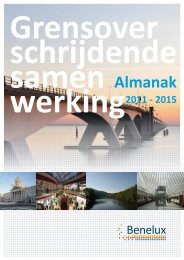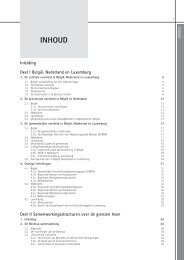The North Seas Countries' Offshore Grid Initiative - Initial ... - Benelux
The North Seas Countries' Offshore Grid Initiative - Initial ... - Benelux
The North Seas Countries' Offshore Grid Initiative - Initial ... - Benelux
Create successful ePaper yourself
Turn your PDF publications into a flip-book with our unique Google optimized e-Paper software.
Although the benefits of the emerging meshing opportunities found in this study may be<br />
marginal for the region, there may be more significant benefits for the involved countries.<br />
<strong>The</strong>re may be added value for TSOs to investigate these opportunities, in close<br />
collaboration with relevant NRAs and Government authorities. It should be noted in this<br />
respect that this study optimised investments for the region; in other words, actions on<br />
specific projects may have implications for neighbouring countries as a result of discrete<br />
decisions taken by its regional neighbours.<br />
This study emphasises the importance of studying scenarios developed against common<br />
foundations to avoid distortions created by differences within the scenario, rather than<br />
genuine market need. Although the radial and meshed approaches produced similar levels<br />
of interconnection, with similar associated production cost savings, there were significant<br />
differences in how they were achieved (e.g. Great Britain-Norway link in the radial design<br />
is replaced by Norway-Germany and flows through Continental Europe in the meshed)<br />
which need to be further investigated.<br />
6.1.4 <strong>The</strong> benefits of meshing<br />
It should be expected that there are quantifiable costs and benefits associated with<br />
adopting a meshed approach to grid design, and these have been assessed as part of this<br />
study. However, there are other less quantifiable implications which include the added<br />
complexity associated with designing and building a meshed grid, increased technology<br />
risk, challenges of operating an integrated DC grid and the need for significant regulatory<br />
adaptation. <strong>The</strong>se may be offset by increased operational flexibility provided by the<br />
meshed network with greater resilience for individual offshore wind developments. In<br />
addition reduced environmental impact should be expected with the potential for larger<br />
cables and fewer landing points.<br />
6.1.5 Sensitivity with increased amount of offshore RES<br />
<strong>The</strong> RES+ sensitivity analysis was used to test whether the benefits of meshing would<br />
increase if the volume of offshore RES were to increase significantly. <strong>The</strong> increased<br />
volumes of offshore RES included in the RES+ sensitivity reflect the most ambitious<br />
offshore RES numbers available to each of the TSOs. As such, they may not be consistent<br />
with formal and/or published Government predictions.<br />
Although the RES+ analysis did not go through the same rigour as the reference scenario<br />
(only half way round the circle), the increased volumes of wind do create a more complex<br />
offshore network in the <strong>North</strong> Sea, with simpler meshed networks emerging in the Irish<br />
Sea and the English Channel and between Great Britain, Norway and Germany as well.<br />
Indicative cost comparisons suggest that meshing results in higher interconnector costs<br />
but lower national reinforcements. Overall costs of the offshore grid in the meshed<br />
design are approximately 7 per cent lower than the radial design. <strong>The</strong> benefit in terms of<br />
production cost reduction has not been assessed for this sensitivity (half way around the<br />
circle).<br />
Page 62 of 142










